Tối ưu hoá điều kiện lên men khô đậu nành và đánh giá hình thái học mô ruột khi sử dụng khô đậu nành để thay thế bột cá ở thức ăn tôm thẻ chân trắng
TÓM TẮT
Nghiên cứu lên men bán rắn khô đậu nành bằng chủng vi khuẩn Bacillus subtilis B3, được phân lập
từ hệ tiêu hoá của tôm, nhằm tạo ra sản phẩm lên men từ đậu nành giúp thay thế bột cá và đánh giá
ảnh hưởng của sản phẩm khi sử dụng làm thức ăn cho tôm thẻ chân trắng. Thông số tối ưu quá trình
lên men bán rắn trên sản phẩm khô đậu nành và khô đậu nành tách kháng dinh dưỡng với Bacillus
subtilis B3 được xác định tại nhiệt độ 37oC, pH 6,5, độ ẩm 50%, độ dày nguyên liệu 4cm. Sản phẩm
đậu nành sau khi lên men (FSBM) gia tăng protein thô 14% so với khô đậu nành(SBM) ban đầu và
đậu nành tách kháng dinh dưỡng thủy phân (FSBMex) tăng protein thô 26% (so với SBM) hay 7,5%
(so với đậu nành tách kháng dinh dưỡng - SBMex). Protein kháng dinh dưỡng trong đậu nành gồm
conglycinin và glycinin đã được thủy phân, có thể do vi khuẩn Bacillus subtilis B3 tiết ra enzyme
protease ngoại bào có hoạt tính mạnh. Nguyên liệu khô đậu nành lên men khi thay thế bột cá đến
mức 40% cho thấy không có ảnh hưởng đến hình thái ruột về độ dài và khoảng cách tơ ruột so với
thức ăn bột cá (FM), và ở nguyên liệu khô đậu nành tách kháng dinh dưỡng lên men khi thay thế
đến mức 60% có hình thái tương tự thức ăn bột cá. Các ảnh hưởng của thức ăn chứa đậu nành lên
men lên hình thái ruột có thể do đậu nành đã thủy phân được protein kháng dinh dưỡng trong đậu
nành conglycinin và glycinin hoặc do trong thức ăn vẫn còn chứa probiotic từ sản phẩm đậu nành
lên men.
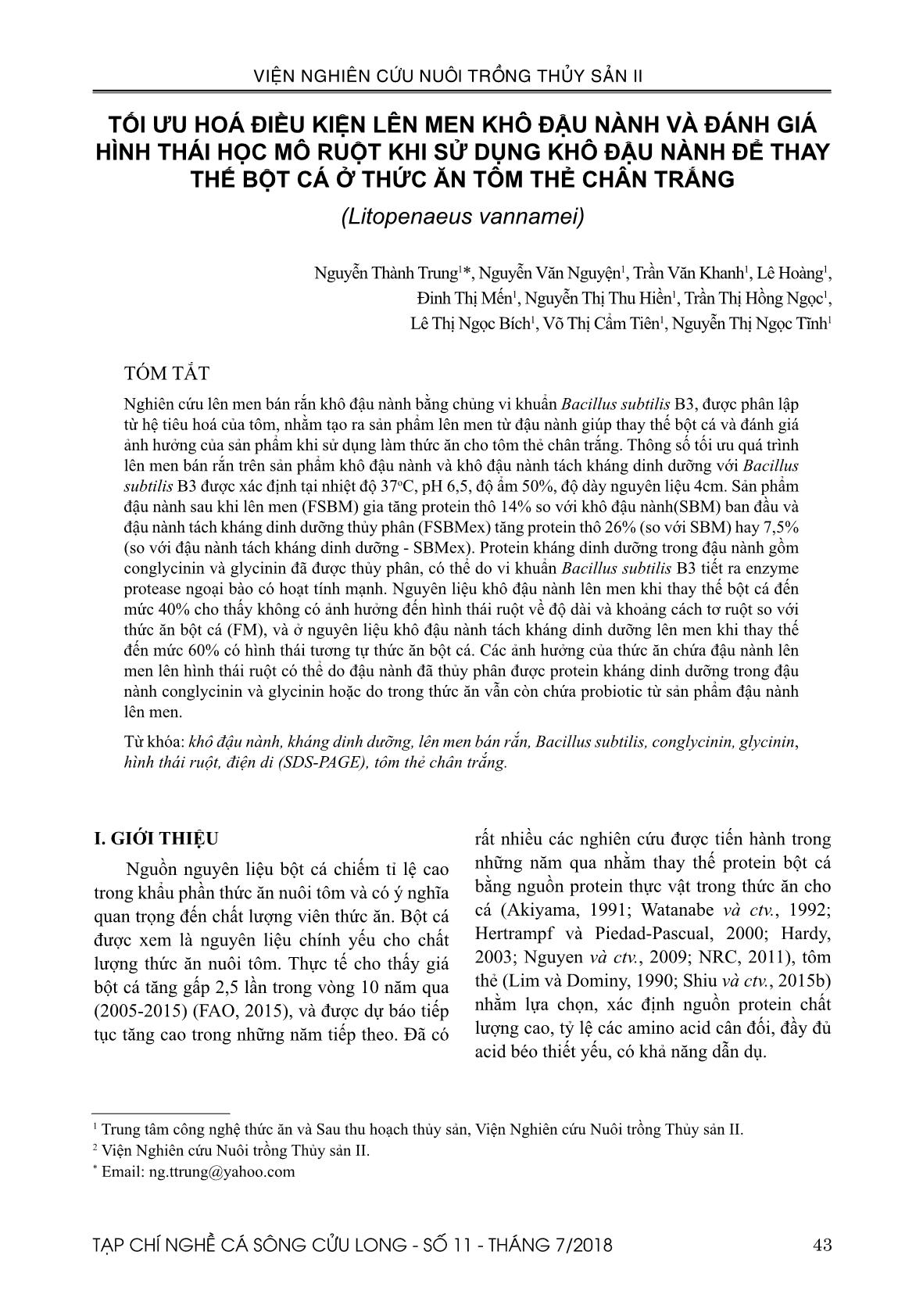
Trang 1

Trang 2
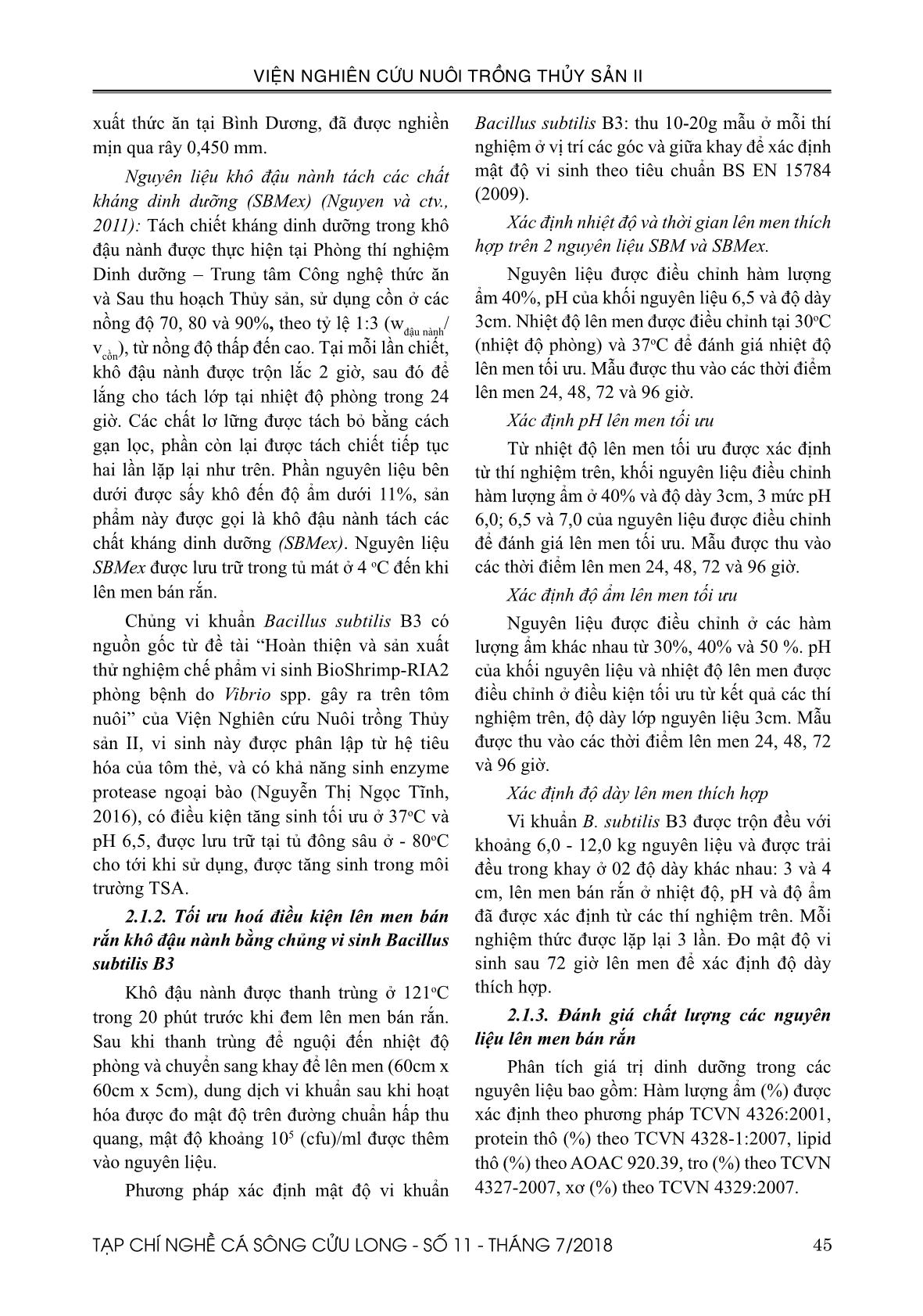
Trang 3
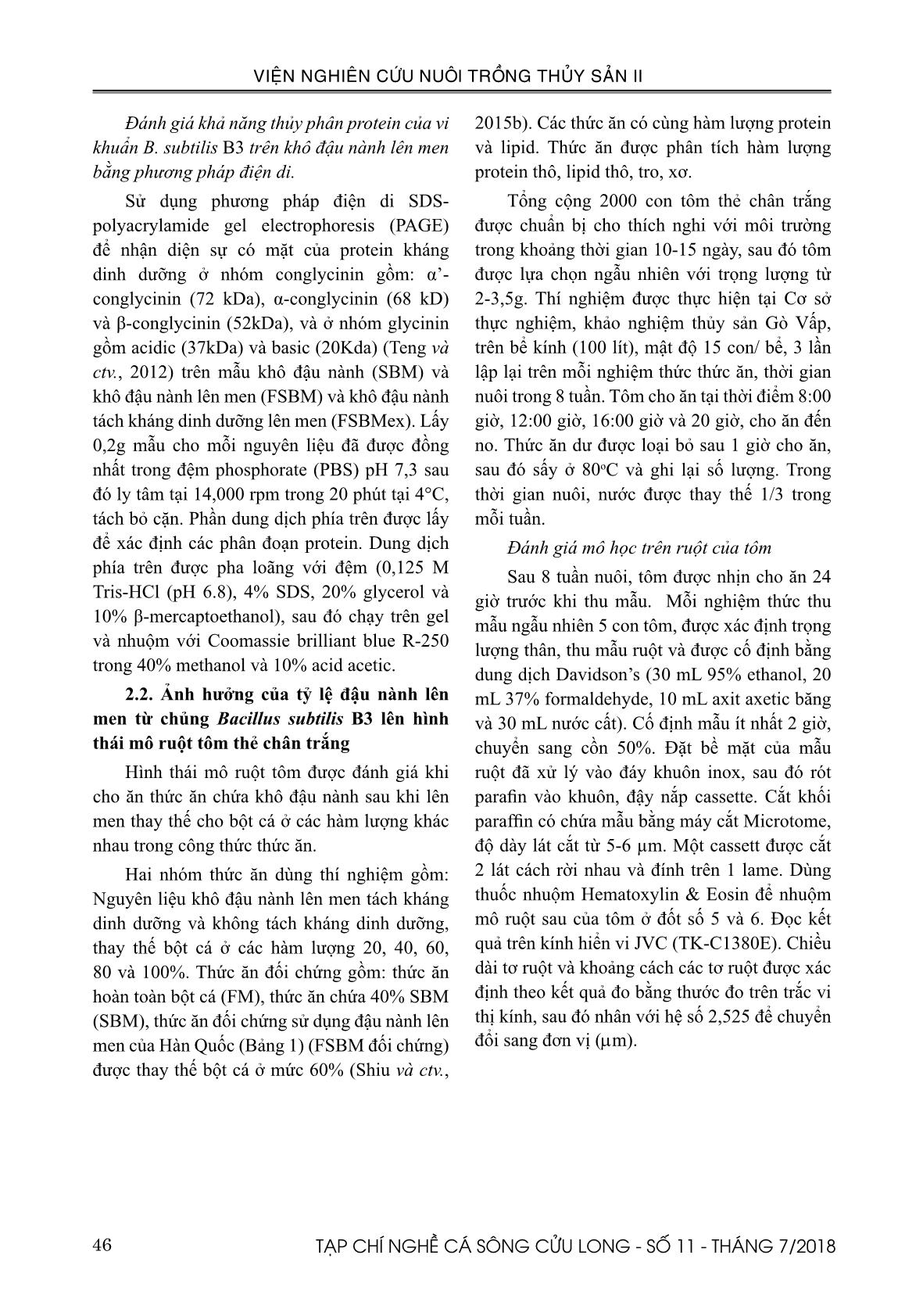
Trang 4
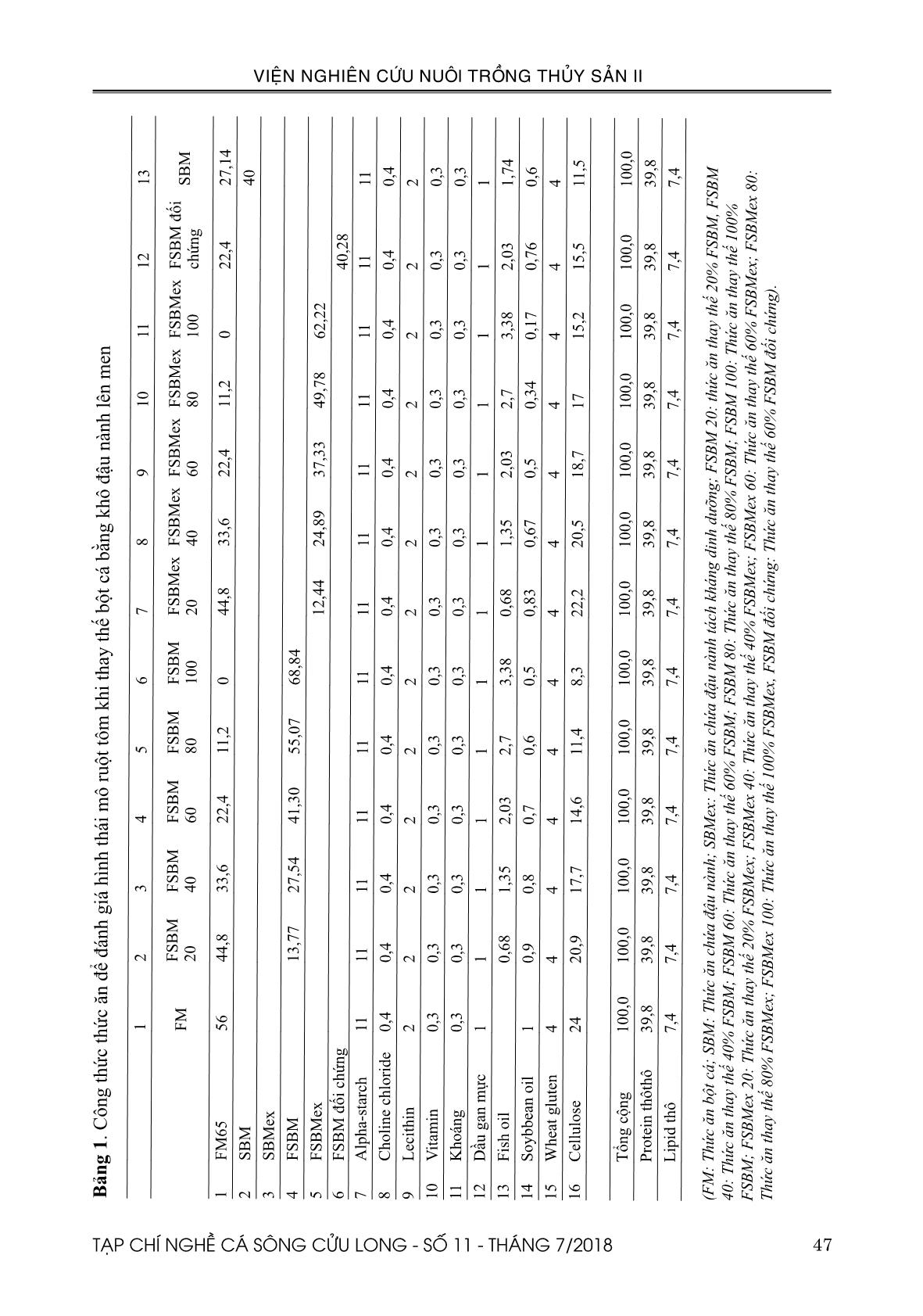
Trang 5

Trang 6
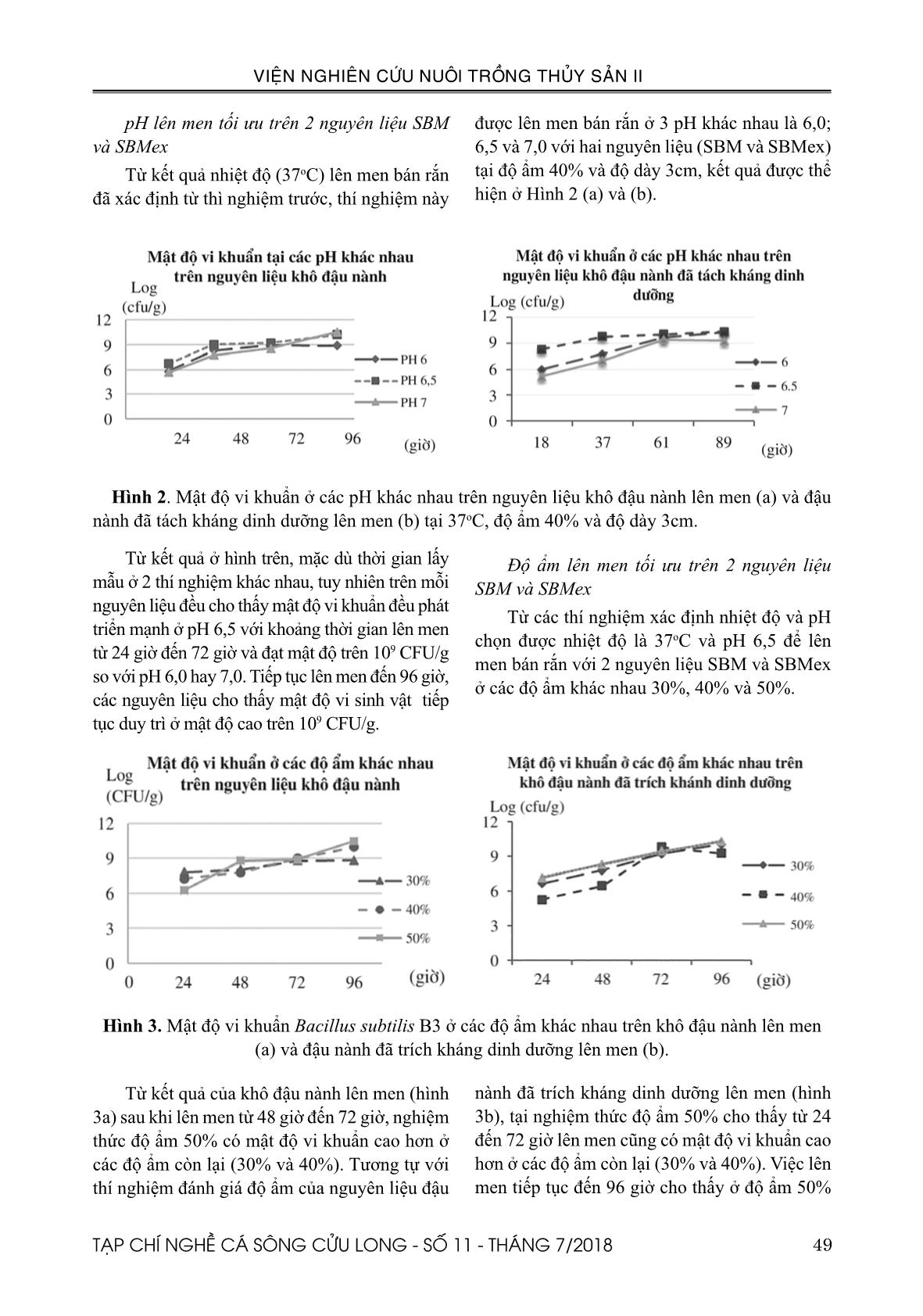
Trang 7

Trang 8
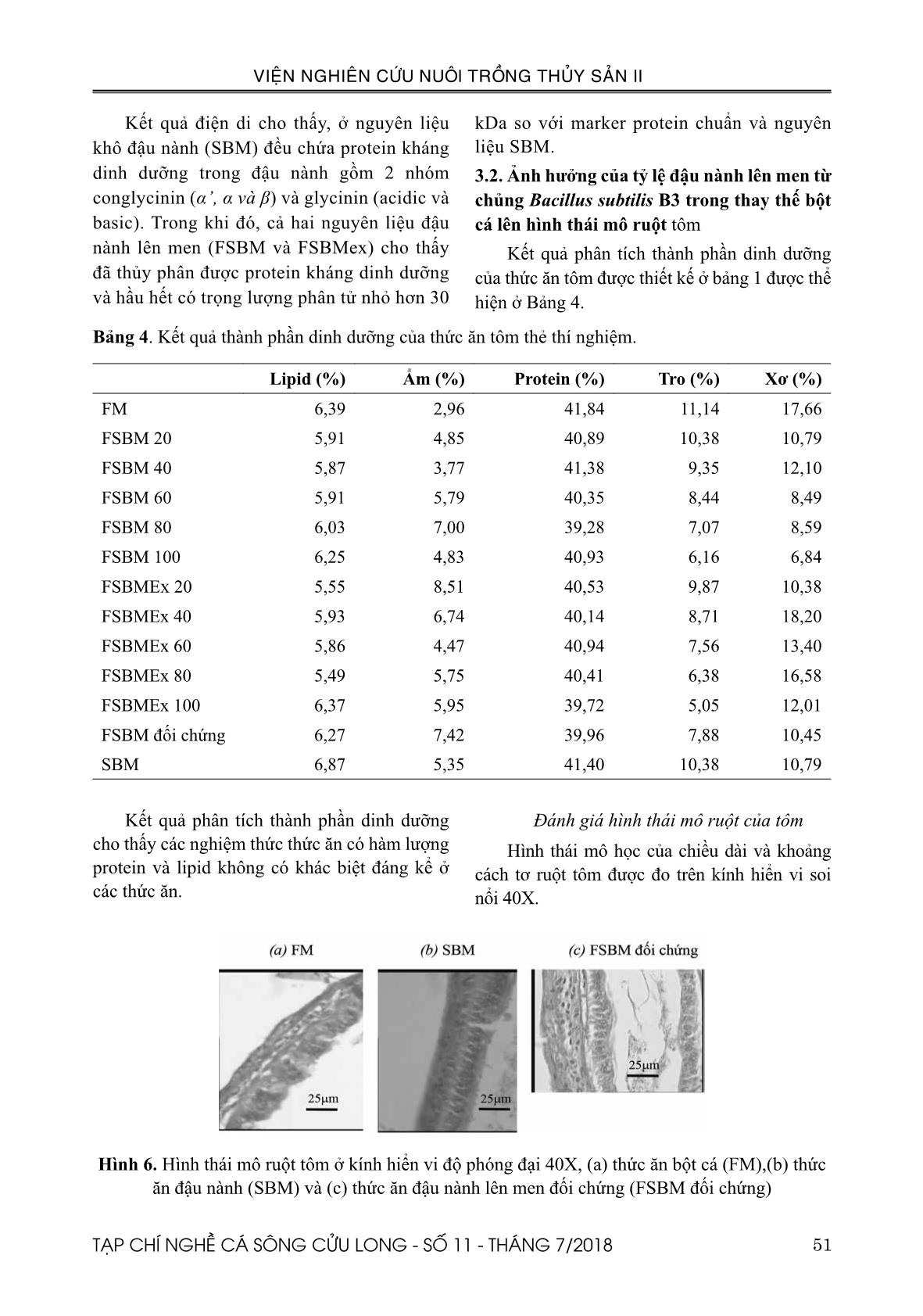
Trang 9
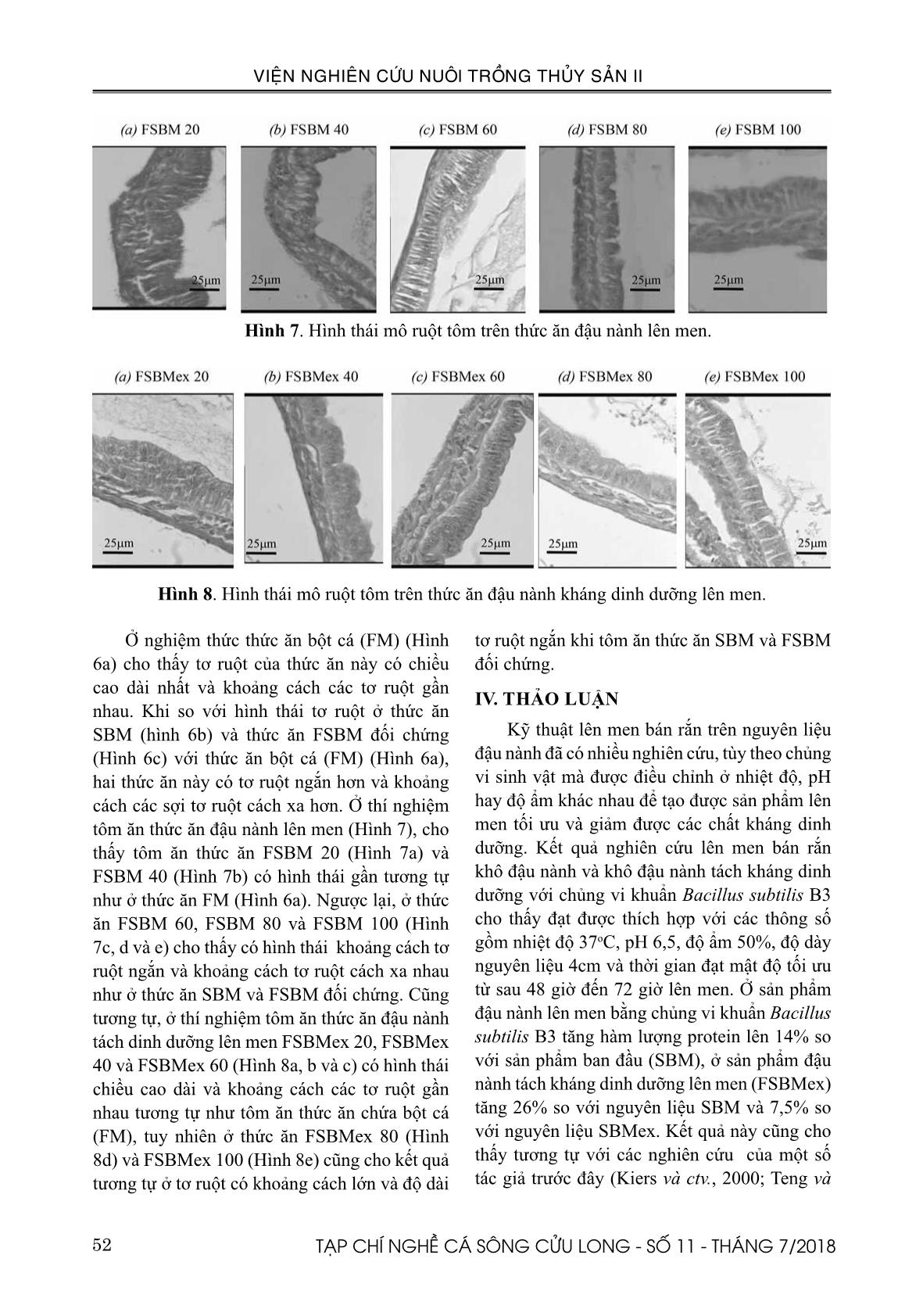
Trang 10
Tải về để xem bản đầy đủ
Tóm tắt nội dung tài liệu: Tối ưu hoá điều kiện lên men khô đậu nành và đánh giá hình thái học mô ruột khi sử dụng khô đậu nành để thay thế bột cá ở thức ăn tôm thẻ chân trắng
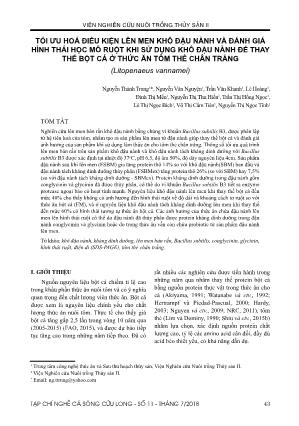
của tôm thẻ chân trắng để lên men các nguyên liệu từ khô đậu nành đã giúp xác định được qui trình lên men bán rắn và nâng cao được hàm lượng protein so với sản phẩm ban đầu. Ngoài ra, quá trình lên men sản phẩm đậu nành này cũng thủy phân được protein kháng dinh dưỡng trong đậu nành gồm nhóm conglycinin và glycinin. Đặc biệt, kết quả ở nguyên liệu tách kháng dinh dưỡng bằng dung môi cồn cho thấy mật độ vi sinh tăng sinh cao hơn với nguyên liệu khô đậu nành không tách kháng dinh dưỡng ở cùng điều kiện lên men, điều này có thể do chất kháng dinh dưỡng cản trở việc lên men đối với vi khuẩn Bacillus subtilis B3. 54 TẠP CHÍ NGHỀ CÁ SÔNG CỬU LONG - SỐ 11 - THÁNG 7/2018 VIỆN NGHIÊN CỨU NUÔI TRỒNG THỦY SẢN II V. KẾT LUẬN VÀ ĐỀ XUẤT 5.1. Kết luận Hàm lượng protein trong nguyên liệu sau khi tách chất kháng khuẩn tăng 17% protein so với nguyên liệu đầu. Chất lượng đậu nành lên men đã được cải thiện về khía cạnh dinh dưỡng khi sản phẩm tăng hơn 14% protein thô so với nguyên liệu đậu nành ban đầu. Sản phẩm đậu nành tách kháng dinh dưỡng sau khi lên men bán rắn bằng chủng Bacillus subtilis B3 tăng hàm lượng protein thô hơn 26% so với đậu nành ban đầu. Các protein kháng dinh dưỡng conglycinin và glycinin trong đậu nành hầu hết đã được thủy phân trong quá trình lên men. Thiết lập được các thông số tối ưu cho việc lên men đậu nành và đậu nành tách kháng dinh dưỡng. Kết quả ảnh hưởng về hình thái mô của ruột tôm có thể do sản phẩm đậu nành lên men đã cải thiện dinh dưỡng tốt, lại bỏ hầu hết chất kháng dinh dưỡng hoặc/và sản phẩm chứa vi khuẩn Bacillus subtilis B3 ở dạng probiotic giúp tôm ăn thức ăn ở dưới mức 40% FSBM và 60% FSBMex có tơ ruột dài và mật độ cao. 5.2. Đề xuất Tiếp tục nuôi đánh giá tiêu hóa và tăng trưởng của tôm để xem xét hiệu quả của sản phẩm. Cần có các nghiên cứu tiếp theo để xem xét về cơ chế ảnh hưởng đậu nành lên men lên hình thái mô học của tôm thẻ chân trắng. TÀI LIỆU THAM KHẢO Nguyễn Thị Ngọc Tĩnh, 2016. Đề tài: Hoàn thiện và sản xuất thử nghiệm chế phẩm vi sinh BioShrimp- RIA2 phòng bệnh do Vibrio spp. gây ra trên tôm nuôi. Viện Nghiên cứu Nuôi trồng Thủy sản II- Bộ Nông nghiệp và Phát triển Nông thôn. Trần Thị Thanh Hiền, Trần Lê Cẩm Tú, Nguyễn Vĩnh Tiến, Nguyễn Bảo Trung, Trần Minh Phú, Phạm Minh Đức, Bengston David, 2014. Thay thế bột cá bằng một số nguồn bột đậu nành trong thức ăn cho cá lóc (Channa striata). Số chuyên đề: Thủy sản - Tạp chí Khoa học Trường Đại học Cần Thơ. 1, 310-318. NRC, 2011. Nutrient Requirements of Fish and Shrimp. The National Academies Press, Washington, DC. Akiyama, D.M., 1991. The use of soy products and other plant protein supplements in aquaculture feeds. American Soybean Association. Azarm, H.M., Lee, S.-M., 2014. Effects of partial substitution of dietary fish meal by fermented soybean meal on growth performance, amino acid and biochemical parameters of juvenile black sea bream Acanthopagrus schlegeli. Aquaculture Research. 45, 994-1003. Barnes, M.E., Brown, M.L., Bruce, T., Sindelar, S., Neiger, R., 2014. Rainbow Trout Rearing Performance, Intestinal Morphology, and Immune Response after Long-term Feeding of High Levels of Fermented Soybean Meal. North American Journal of Aquaculture. 76, 333-345. Barnes, M.E., Brown, M.L., Rosentrater, K.A., Sewell, J.R., 2012. An initial investigation replacing fish meal with a commercial fermented soybean meal product in the diets of juvenile rainbow trout. Open Journal of Animal Sciences. 02, 234-243. Barrows, F.T., Stone, D.A.J., Hardy, R.W., 2007. The effects of extrusion conditions on the nutritional value of soybean meal for rainbow trout (Oncorhynchus mykiss). Aquaculture. 265, 244-252. BS EN 15784, 2009. Animal feeding stuffs. Isolation and enumeration of presumptive. Chikwati, E.M., Venold, F.F., Penn, M.H., Rohloff, J., Refstie, S., Guttvik, A., Hillestad, M., Krogdahl, A., 2012. Interaction of soyasaponins with plant ingredients in diets for Atlantic salmon, Salmo salar L. The British journal of nutrition. 107, 1570-1590. Daniels, C.L., Merrifield, D.L., Boothroyd, D.P., Davies, S.J., Factor, J.R., Arnold, K.E., 2010. Effect of dietary Bacillus spp. and mannan oligosaccharides (MOS) on European lobster (Homarus gammarus L.) larvae growth performance, gut morphology and gut 55TẠP CHÍ NGHỀ CÁ SÔNG CỬU LONG - SỐ 11 - THÁNG 7/2018 VIỆN NGHIÊN CỨU NUÔI TRỒNG THỦY SẢN II microbiota. Aquaculture. 304, 49-57. FAO, 2015. OECD/Food and Agriculture Organization of the United Nations (2015). OECD-FAO Agricultural Outlook 2015. OECD Publishing, Paris. Feng, J., Liu, X., Xu, Z.R., Lu, Y.P., Liu, Y.Y., 2007. The effect of Aspergillus oryzae fermented soybean meal on growth performance, digestibility of dietary components and activities of intestinal enzymes in weaned piglets. Animal Feed Science and Technology. 134, 295-303. Francis, G., Makkar, H.P.S., Becker, K., 2001. Antinutritional factors present in plant-derived alternate fish feed ingredients and their effects in fish. Aquaculture. 199, 197-227. Gomes, E.F., Rema, P., Kaushik, S.J., 1995 Replacement of fish meal by plant proteins in the diet of rainbow trout (Oncorhynchus mykiss) : digestibility and growth performance. Aquaculture 130 177-186. Hardy, R.W., 2003. Use of Soybean Meals in Diets of Salmon and Trout. Technical factsheet written in conjunction with United Soybean Board and American Soybean Association. soymeal. org/FactSheets/SalmonidTechReview. pdf (accessed February 28, 2013). Hertrampf, J.W., Piedad-Pascual, F., 2000. Handbook on ingredients for aquaculture feeds, Kluwer Academic Publishers,. Hirabayashi, M., Matsui, T., Yano, H., 1998. Fermentation of Soybean Meal with Aspergilus usamii Improves Zinc Availability in Rats. Biological Trace Element Research. 61, 227- 233. Ingh, T.S.G.A.M.v.d., Krogdahl, Å., Olli, J.J., Hendriks, H.G.C.J.M., Koninkx, J.G.J.F., 1991. Effects of soybean-containing diets on the proximal and distal intestine in Atlantic salmon (Salmo salar): a morphological study. Aquaculture. 94, 297-305. Kiers, J.L., laeken, A.E.A.V., Rombouts, F.M., Nout, M.J.R., 2000. In vitro digestibility of Bacillus fermented soya bean. International Journal of Food Microbiology. 60, 163-169. Knudsen, D., Jutfelt, F., Sundh, H., Sundell, K., Koppe, W., Frokiaer, H., 2008. Dietary soya saponins increase gut permeability and play a key role in the onset of soyabean-induced enteritis in Atlantic salmon ( Salmo salar L.). The British journal of nutrition. 100, 120-129. Knudsen, D., Urán, P., Arnous, A., Koppe, W., Frøkiær, H., 2007. Saponin-Containing Subfractions of Soybean Molasses Induce Enteritis in the Distal Intestine of Atlantic Salmon. J. Agric. Food Chem. 55, 2261-2267. Krogdahl, A., Gajardo, K., Kortner, T.M., Penn, M., Gu, M., Berge, G.M., Bakke, A.M., 2015. Soya Saponins Induce Enteritis in Atlantic Salmon (Salmo salar L.). Journal of agricultural and food chemistry. 63, 3887-3902. Lim, C., Dominy, W., 1990. Evaluation of soybean meal as a replacement for marine animal protein in diets for shrimp (Penaeus vannamei). Aquaculture. 87, 53-56. Lim, S.-J., Kim, S.-S., Pham, M.A., Song, J.-W., Cha, J.-H., Kim, J.-D., Kim, J.-U., Lee, K.- J., 2010. Effects of Fermented Cottonseed and Soybean Meal with Phytase Supplementation on Gossypol Degradation, Phosphorus Availability, and Growth Performance of Olive Flounder (Paralichthys olivaceus). Fish Aqua Sci. 13, 284-293. Matsunari, H., Iwashita, Y., Suzuki, N., Saito, T., Akimoto, A., Okamatsu, K., Sugita, T., Yamamoto, T., 2010. Influence of fermented soybean meal-based diet on the biliary bile status and intestinal and liver morphology of rainbow trout Oncorhynchus mykiss. Aquaculture Sci. 58, 243-252. Murashita, K., Akimoto, A., Iwashita, Y., Amano, S., Suzuki, N., Matsunari, H., Furuita, H., Sugita, T., Yamamoto, T., 2013. Effects of biotechnologically processed soybean meals in a nonfishmeal diet on growth performance, bile acid status, and morphological condition of the distal intestine and liver of rainbow trout Oncorhynchus mykiss. Fisheries Science. 79, 447-457. Nguyen, H.P., Khaoian, P., Furutani, T., Nagano, 56 TẠP CHÍ NGHỀ CÁ SÔNG CỬU LONG - SỐ 11 - THÁNG 7/2018 VIỆN NGHIÊN CỨU NUÔI TRỒNG THỦY SẢN II J., Fukada, H., Masumoto, T., 2011. Effects of alcohol extract from soybean meal on pancreatic digestive enzyme and bile acid secretion in yellowtail Seriola quinqueradiata Aquaculture Science. 59, 465-472. Nguyen Thanh Trung, Matsumoto, Y., Masumoto, T., 2016a. Effect of soybean meal diet on color and morphology of distal intestine of juvenile yellowtail (Seriola quinqueradiata). International Fisheries Symposium - Can Tho University publishing house. Nguyen Thanh Trung, Nguyen, N.V., Matsumoto, Y., Masumoto, T., 2016b. Effect of selected anti- nutrient componentsof soybean meal on intestine color and morphology of yellowtail (Seriola quinqueradiata). The 8th Regional Aquafeed Forum- Feed and Feeding Management for Better Aquaculture - Nong Lam University, Vietnam 8, p.28. Nguyen, T.N., Davis, D.A., Saoud, P., 2009. Evaluation of Alternative Protein Sources to Replace Fish Meal in Practical Diets for Juvenile Tilapia, Oreochromis spp. Journal of The World Aquaculture Society. 40, 113-121. Nguyen Van Nguyen, Hoang, L., Van Khanh, T., Duy Hai, P., Hung, L.T., 2018. Utilization of fermented soybean meal for fishmeal substitution in diets of Pacific white shrimp (Litopenaeus vannamei). Aquaculture Nutrition. 24, 1092- 1100. Olli, J.J., Krogdahl, Å., 1995. Alcohol soluble components of soybeans seem to reduce fat digestibility in fish-meal-based diets for Atlantic salmon, Salmo salar L. Aquaculture Research. 26, 831-835. Rombenso, A., Crouse, C., Trushenski, J., 2013. Comparison of Traditional and Fermented Soybean Meals as Alternatives to Fish Meal in Hybrid Striped Bass Feeds. North American Journal of Aquaculture. 75, 197-204. Shimeno, S., Mima, T., Yamamoto, O., Ando, Y., 1993. Effects of Fermented Defatted Soybean Meal in Diet on the Growth, Feed Conversion, and Body Composition of Juvenile Yellowtail. Nippon Suisan Gakkaishi 59 1883-1888. Shiu, Y.-L., Hsieh, S.-L., Guei, W.-C., Tsai, Y.- T., Chiu, C.-H., Liu, C.-H., 2015a. Using Bacillus subtilis E20-fermented soybean meal as replacement for fish meal in the diet of orange-spotted grouper (Epinephelus coioides, Hamilton). Aquaculture Research. 46, 1403- 1416. Shiu, Y.-L., Wong, S.-L., Guei, W.-C., Shin, Y.-C., Liu, C.-H., 2015b. Increase in the plant protein ratio in the diet of white shrimp, Litopenaeus vannamei (Boone), using Bacillus subtilis E20- fermented soybean meal as a replacement. Aquaculture Research. 46, 382-394. Teng, D., Gao, M., Yang, Y., Liu, B., Tian, Z., Wang, J., 2012. Bio-modification of soybean meal with Bacillus subtilis or Aspergillus oryzae. Biocatalysis and Agricultural Biotechnology. 1, 32-38. Watanabe, T., Viyakarn, V., Kimura, H., Ogawa, K., Okamoto, N., Iso, N., 1992. Utilization of Soybean Meal as a Protein Source in a Newly Developed Soft-dry Pellet for Yellowtail. Nippon Suisan Gakkaishi. 58, 1761-1773. Yamamoto, T., Iwashita, Y., Matsunari, H., Sugita, T., Furuita, H., Akimoto, A., Okamatsu, K., Suzuki, N., 2010. Influence of fermentation conditions for soybean meal in a non-fish meal diet on the growth performance and physiological condition of rainbow trout Oncorhynchus mykiss. Aquaculture. 309, 173-180. Yamamoto, T., Matsunari, H., Sugita, T., Furuita, H., Masumoto, T., Iwashita, Y., Amano, S., Suzuki, N., 2012a. Optimization of the supplemental essential amino acids to a fish meal-free diet based on fermented soybean meal for rainbow trout Oncorhynchus mykiss. Fisheries Science. 78, 359-366. Yamamoto, T., Murashita, K., Matsunari, H., Sugita, T., Furuita, H., Iwashita, Y., Amano, S., Suzuki, N., 2012b. Influence of dietary soy protein and peptide products on bile acid status and distal intestinal morphology of rainbow trout Oncorhynchus mykiss. Fisheries Science. 78, 1273-1283. Zhang, J., Liu, Y., Tian, L., Yang, H., Liang, G., Xu, D., 2012. Effects of dietary mannan 57TẠP CHÍ NGHỀ CÁ SÔNG CỬU LONG - SỐ 11 - THÁNG 7/2018 VIỆN NGHIÊN CỨU NUÔI TRỒNG THỦY SẢN II oligosaccharide on growth performance, gut morphology and stress tolerance of juvenile Pacific white shrimp, Litopenaeus vannamei. Fish & shellfish immunology. 33, 1027-1032. Zheng, X., Duan, Y., Dong, H., Zhang, J., 2017. Effects of Dietary Lactobacillus plantarum on Growth Performance, Digestive Enzymes and Gut Morphology of Litopenaeus vannamei. Probiotics Antimicrob Proteins. 58 TẠP CHÍ NGHỀ CÁ SÔNG CỬU LONG - SỐ 11 - THÁNG 7/2018 VIỆN NGHIÊN CỨU NUÔI TRỒNG THỦY SẢN II OPTIMIZING FERMENTATION CONDITIONS FOR SOYBEAN MEAL AND THE CHANGES IN INTESTINE MORPHOLOGY AS SOYBEAN MEAL IS SUBSTITUTED FOR FISH MEAL IN WHITE LEG SHRIMP (Litopenaeus vannamei) DIET Nguyen Thanh Trung1*, Nguyen Van Nguyen1, Tran Van Khanh1, Le Hoang1, Dinh Thi Men1, Nguyen Thi Thu Hien1, Tran Thi Hong Ngoc1, Le Thi Ngoc Bich1, Vo Thi Cam Tien1, Nguyen Thi Ngoc Tinh2 ABSTRACT This experiment was conducted to optimize the solid-state fermentation conditions of soybean meal (SBM) and alcohol extracted anti-nutrient soybean meal (SBMex) by Bacillus subtilis B3, which was isolated from white leg shrimp digestive tract. The optimum fermentation parameters found for SBM and SBMex ingredients were as follows: 37oC, pH 6,5, moisture 50%, material layer 4cm. Under these conditions, bacterial density reached higher 109 cell per gram after 48 hours of fermentation. Bacillus subtilis B3 may have high proteolytic activity in hydrolyzing antigenic protein in soybean, such as conglycinin and glycinin. The morphological observation of intestines at fish meal (FM) replacement rates of 40% FSBM and 60% FSBMex in shrimp diet showed similar enterocytes height and enterocytes density under light micrographs conditions. The effect on intestine morphology may be due to the fermented products contain probiotic bacteria which were able to hydrolyze antigenic proteins in soybean meal. Keywords: white leg shrimp, soybean meal, anti-nutrition factors, solid-state fermentation, Bacillus subtilis, antigenic protein in soybean, intestine morphology. Người phản biện: TS. La Xuân Thảo Ngày nhận bài: 15/6/2018 Ngày thông qua phản biện: 30/6/2018 Ngày duyệt đăng: 10/7/2018 1 Research Center for Aqua-Feed Nutrition and Fishery Post-Harvest Technology, Research Institute for Aquaculture No.2 2 Research Institute for Aquaculture No.2 * Email:ng.ttrung@yahoo.com
File đính kèm:
 toi_uu_hoa_dieu_kien_len_men_kho_dau_nanh_va_danh_gia_hinh_t.pdf
toi_uu_hoa_dieu_kien_len_men_kho_dau_nanh_va_danh_gia_hinh_t.pdf

